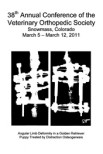Objective: To retrospectively compare functional outcomes of femoral head ostectomy (FHO) between dogs receiving surgery for chronic coxofemoral disease (CD) versus acute traumatic injury (AT).
Methods: Medical records of dogs undergoing FHO at 4 hospitals between January 2014 and August 2023 were reviewed. Demographic data, body weight, body condition score (BCS), indication for FHO (CD vs AT), pre- and postoperative lameness scores, and postoperative complications were recorded. Information was gathered via client survey regarding postoperative physiotherapy, ability (average disability score), and client assessment of quality of life at the owner-perceived peak postoperative health.
Results: 68 cases (CD, n = 27; AT, 41) met inclusion criteria. Chronic disease cases were younger with lower BCS than AT cases. Median (IQR) preoperative lameness scores were higher in AT cases (5.0/5.0 [4.0 to 5.0]) than CD cases (2.5/5.0 [1.5 to 4.0]) and were equivalent in both groups (2/5 [1.0 to 3.0]) after 4 to 6 postoperative weeks. Forty-one cases (60.3%) were treated with capsulorrhaphy during FHO, with significantly more AT dogs treated (CD, n = 12; AT, 29). Minor and major complications were reported in 23 (33.8%) and 9 (13.2%) cases, respectively. Joint capsulorrhaphy was associated with higher ambulation and lower disability scores. Postoperative physiotherapy was not associated with improved long-term outcomes.
Conclusions: Regardless of indication, dogs receiving FHO reached similar levels of function but never achieved normal ambulation. Joint capsulorrhaphy was associated with improved functional outcomes.
Clinical relevance: These findings may help guide expectations for dogs receiving FHO. Additionally, joint capsulorrhaphy may be preferable in FHO cases.









